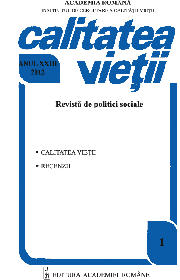În căutarea unui indicator veritabil al bunăstării
In search of a genuine welfare index
Author(s): Iulia Monica Oehler-ŞincaiSubject(s): Social Sciences
Published by: Editura Academiei Române
Keywords: welfare; genuine welfare index; indicators that adjust GDP; composite indexes
Summary/Abstract: This paper focuses on the worldwide increasing efforts to gauge the genuine welfare. The purpose of our investigation is three-fold. First, it aims to present the evolution of the concept of welfare and its determinants, starting from the subjective approach. Second, our research brings to the forefront the typology of the welfare indexes. In spite of many weaknesses, these are more relevant than a unilateral metric, as they incorporate, besides GDP, dimensions such as those referring to education, environment and quality of government. Third, our investigation underlines that even though some emerging countries (like BRICs) are among the most powerful countries in the world in terms of GDP, they lag behind others, if we take into consideration the aggregate wellbeing, stressing once more the need for a genuine worldwide welfare index. At a subjective level, the welfare perception varies from one person to another, from country to country, and even from region to region, depending on a complex of factors. More than that, choices, preferences and habits change, together with the technical progress. As a consequence, a transversal and longitudinal analysis of welfare is almost impossible. That is the main reason why the objective indicators are needed. In the category of objective welfare indicators there are included indexes that correct GDP, i.e. that diminish its value by the externalities that eventually have a negative effect on welfare. Among the indexes “beyond GDP” that reflect welfare we can mention: the measure of economic welfare (MEW), index of sustainable economic welfare (ISEW), genuine progress indicator (GPI), the green GDP or sustainable net benefit index (SNBI). In our analysis there are also highlighted composite indexes, such as UNDP human development index, OECD better life index or social progress index. In spite of some weaknesses, these indexes facilitate international comparisons, as well as long term analyses. The indicators and indexes presented in this paper emphasize the efforts made by scholars, international organisations and governments to gauge the welfare in the modern society. The need for genuine welfare index, “beyond GDP”, is correlated with the negative externalities of economic growth and, consequently, the shortcomings of GDP as a measure of welfare. There are many obstacles to periodically calculate a genuine indicator of wellbeing for all countries of the world. Among these, there are the lack of consensus on the adequate methodology, the complexity of data collecting and related costs. So far, the solution most suitable to capture all facets of welfare is the satellite accounts for each dimension of well-being (on health, education and so on). Taking into account this rationale, our paper is structured in three main parts as follows: 1. What is wellbeing and which are its main determinants? 2. Why do we need an authentic welfare indicator? 3. Typology of the welfareindicators.
Journal: Calitatea vieţii
- Issue Year: XXV/2014
- Issue No: 1
- Page Range: 62-81
- Page Count: 20

